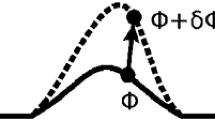Abstract
A method is developed for optimizing the complex thermo-fluid phenomena that occur in welding processes where fluid convection is present. A mathematical model of a typical welding problem which includes conservation of mass, momentum and energy, and assumes that the process is steady in the frame of reference moving with the heat source is considered. An optimal control problem in which the heat input from the heat source is determined to ensure a prescribed geometry of the weld is formulated and solved. The problem is solved with a gradient-based optimization approach in which the gradient (sensitivity) of the cost functional with respect to the control variables is determined using a suitably defined adjoint system. An important aspect of the problem is that it is of the free-boundary type. Therefore it is necessary to use methods of the shape calculus to derive the adjoint equations. A number of computational results which validate our approach and feature qualitatively different flow patterns in problems with different material properties are presented.
Similar content being viewed by others

References
Lancaster JF (1986) The physics of welding. Pergamon Press, Oxford
Na S-J, Lho T-J (1996) A study on parameter optimization for circumferential gas tungsten arc (GTA) welding of small pipes considering backing gas pressure. Part 2: process optimization. Proc Inst Mech Eng 210: 87–91
Kim D, Rhee S (2001) Optimization of arc welding process parameters using a genetic algorithm. Weld J 80: 184–189
De A, DebRoy T (2006) Improving reliability of heat and fluid flow calculations during conduction model laser spot welding by multi-variable optimization. Sci Technol Weld Join 11: 143–153
Zabaras N (1998) Adjoint methods for inverse free convection problems with application to solidification processes. In: Borggaard J, Cliff E, Schreck S, Burns J (eds) Computational methods for optimal design and control (Birkhauser series in progress in systems and control theory). Birkhauser, New York, pp 391–426
Hinze M, Ziegenbald S (2007) Optimal control of the free boundary in a two-phase Stefan problem. J Comput Phys 223: 657–684
Dowden JM (2001) Mathematics of thermal modelling: an introduction to the theory of laser material processing. CRC Press, Boca Raton
Wang Y, Tsai HL, Martin SP, Wang PC (2002) Modeling heat and mass transfer and fluid flow in three-dimensional gas metal arc welding. In: Proceedings of IMECE 2002
Zhao PC, Wu CS, Zhang YM (2004) Numerical simulation of the dynamic characteristics of weld pool geometry with step changes of welding parameters. Model Simul Mater Sci Eng 12: 765–780
Bewley TR (2001) Flow control: new challenges for a new renaissance. Prog Aerosp Sci 37: 21–58
Kalnay E (2003) Atmospheric modeling, data assimilation and predictability. Cambridge University Press, New York
Cerviño LI, Bewley TR, Freund JB, Lele SK (2002) Perturbation and adjoint analyses of flow-acoustic interactions in an unsteady 2D jet. In: Center for turbulence research, proceedings of the summer program 2002, pp 27–40
Gunzburger MD (2003) Perspectives in flow control and optimization. SIAM, Philadelphia
Nocedal J, Wright S (2002) Numerical optimization. Springer, New York
Protas B, Liao W (2008) Adjoint-based optimization of PDEs in moving domains. J Comput Phys 227: 2707–2723
Neittaanmaki P, Sprekels J, Tiba D (2006) Optimization of elliptic systems: theory and applications. Springer, Berlin
Volkov O, Protas B (2009) An inverse model for a free-boundary problem with a contact line: steady case. J Comp Phys (in press)
Gurtin ME (1993) Thermomechanics of evolving phase boundaries in the plane. Oxford University Press, Oxford
Engl H, Hanke M, Neubauer A (1996) Regularization of inverse problems. Kluver, Dordrecht
Sokolowski J, Zolésio J-P (1992) Introduction to shape optimization: shape sensitivity analysis. Springer, Berlin
Delfour MC, Zolésio J-P (2001) Shape and geometries—analysis, Differential Calculus and Optimization. SIAM, Philadelphia
Haslinger J, Mäkinen RAE (2003) Introduction to shape optimization: theory, approximation and computation. SIAM, Philadelphia
Mohammadi B, Pironeau O (2004) Shape optimization in fluid mechanics. Annu Rev Fluid Mech 36: 255–279
Simon J (1980) Differentiation with respect to domain in boundary value problems. Numer Funct Anal Optim 2(7&8): 649–687
Berger MS (1977) Nonlinearity and functional analysis. Academic Press, New York
Adams RA, Fournier JF (2005) Sobolev spaces. Academic Press, New York
Protas B, Bewley T, Hagen G (2004) A comprehensive framework for the regularization of adjoint analysis in multiscale PDE systems. J Comput Phys 195(1): 49–89
See www.comsol.com
Sarou-Kanian V, Millot F, Rifflet JC (2003) Surface tension and density of oxygen-free liquid aluminum at high temperature. Int J Thermophys 24: 277–286
Holman JP (2002) Heat transfer. McGraw-Hill, New York
Tanaka M, Lowke JJ (2007) Predictions of weld pool profiles using plasma physics. J Phys D 40: R1–R23
Homescu C, Navon IM, Li Z (2002) Suppression of vortex shedding for flow around a circular cylinder using optimal control. Int J Numer Meth Fluids 38: 43–69
Moubachir M, Zolésio J-P (2006) Moving shape analysis and control—applications to fluid structure interactions. Chapman & Hall, Boca Raton
Author information
Authors and Affiliations
Corresponding author
Rights and permissions
About this article
Cite this article
Volkov, O., Protas, B., Liao, W. et al. Adjoint-based optimization of thermo-fluid phenomena in welding processes. J Eng Math 65, 201–220 (2009). https://doi.org/10.1007/s10665-009-9292-0
Received:
Accepted:
Published:
Issue Date:
DOI: https://doi.org/10.1007/s10665-009-9292-0



